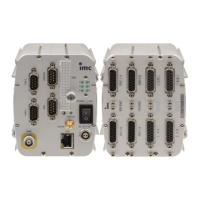© 2018 imc Test & Measurement GmbH
imc C-SERIES - Manual, Version 4 R 3 - 2018-10-19
18 Start of operation with the Hardware
2.12.1 Buffering time constant and maximum buffer duration
The buffer time constant is a permanently configurable device parameter which can be selected as a
order option. It sets the maximum duration of a continuous power outage after which the device turns
itself off.
The maximum buffer duration is the maximum (total) time, determined by the battery capacity, which
the device can run on backup. This refers to cases where the self-deactivation is not triggered; e.g., in
case of repeated short-term power-interruptions. The maximum buffer duration depends on the
battery's current charge, on the ambient temperature and on the battery's age. The device automatically
deactivates itself just in time to avoid deep discharge of the battery.
The buffer time constant can be changed, only with CL devices, using the imc operating software.
·
Please find the technical specs here: "General technical Specs "
Please distinguish between NiMH batteries in CL devices from the Super-Caps,
that are integrated in CS devices.
·
See description in the manual of the imc operating software:
> Operation > User Interface > Device - menu > Properties...: Entry UPS
2.12.2 Charging power
The charging power depends on the device type, its hardware configuration, and the amount and type of
rechargeable batteries installed. For this reason, there are a variety of combinations with charging power
between 2.4 W and 16 W.
2.12.3 Take-over threshold
The voltage threshold at which the storage battery takes over the power supply from the external source
is approx. 9.75 V (8.1 V for CS). The take-over procedure is subjected to an hysteresis to prevent
oscillating take-over. This would be caused by the external supply's impedance. This inevitable
impedance lets the external supply rise again, right after take-over to internal buffering. Hysteresis in the
take-over threshold will prevent oscillations due to this effect. If, during supply from of the buffering
battery, the external supply voltage rises as high as 10.9 V (9 V for CS), the external voltage takes over
again from the buffering battery.
If you check these thresholds, note that when the supply voltage is overlaid with a high frequency
interference or ripple-voltage, the minima are of key importance. In fact, the overlying interference could
be caused by feedback from the device itself!
·
The voltage specification refers to the device terminals. Please consider the voltage drop of the
supply line, when determining the voltage supply.
·
During activation the supply voltage must be above the upper take-over threshold (
³
11 V).
126

